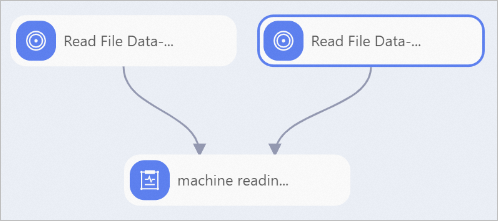The machine reading comprehension training component provided by Platform for AI (PAI) trains machine reading comprehension (MRC) models to read and comprehend given text passages and answer relevant questions. You can use the trained models to implement text-based intelligent conversation. This topic describes how to configure the component and provides an example on how to use the component.
Limits
You can use the machine reading comprehension training component based only on the computing resources of Deep Learning Containers (DLC).
Configure the component in Machine Learning Designer
Input ports
Input port (from left to right)
Data type
Recommended upstream component
Required
Training data
OSS
Yes
Validation data
OSS
Yes
Component parameters
Tab
Parameter
Description
Fields Setting
Language
The language of the input file. Default value: zh. Valid values:
zh
en
Input Schema
The data schema of each column in the input file. Separate multiple columns with commas (,). Default value: qas_id:str:1,context_text:str:1,question_text:str:1,answer_text:str:1,start_position_character:str:1,title:str:1.
Question Column
The name of the column that contains questions in the input file. Default value: question_text.
Context Column
The name of the column that contains text passages in the input file. Default value: context_text.
Answer Column
The name of the column that contains answers in the input file. Default value: answer_text.
Id Column
The name of the ID column in the input file. Default value: qas_id.
Start Position Column
The name of the column that contains the starting positions of answer spans in the input file. If the answer to a question can be found in the text passage, the starting position of the answer span is recorded in this column. Default value: start_position_character.
Model Save Path
The path of the Object Storage Service (OSS) bucket that stores the trained or fine-tuned MRC model.
Parameters Setting
Batch Size
The number of samples that you want to process at a time. The value must be of the INT type. Default value: 4. If the model is trained on multiple workers with multiple GPUs, this parameter specifies the number of samples that are processed by each GPU per batch.
Max Context Length
The maximum length of a text passage that can be handled. The value must be of the INT type. Default value: 384.
Max Query Length
The maximum length of a question that can be handled. The value must be of the INT type. Default value: 64.
Doc Stride
The length of a sliding window for each sliced text passage. The value must be of the INT type. Default value: 128.
Num Epochs
The total number of epochs for training. The value must be of the INT type. Default value: 3.
Learning Rate
The learning rate during model training. The value must be of the FLOAT type. Default value: 3.5e-5.
Save Checkpoint Steps
The number of steps that are taken before the system evaluates the model and saves the optimal model. The value must be of the INT type. Default value: 600.
Model selection
The name or path of the pre-trained model provided by the system. Default value: hfl/macbert-base-zh. Valid values:
User Defined
hfl/macbert-base-zh
hfl/macbert-large-zh
bert-base-uncased
bert-large-uncased
Custom Model Paths
This parameter is available only if you set the Model selection parameter to User Defined.
If you want to use a custom pre-trained or fine-tuned model, specify the model parameters in the
{A: xxx, B: xxx}format. Separate keys and values with colons (:). Separate multiple parameters with commas (,).Tuning
GPU Machine Type
The instance type of the GPU-accelerated node that you want to use. The default value is gn5-c8g1.2xlarge, which specifies that the node uses 8 vCPUs, 80 GB memory, and a single P100 GPU.
num_GPU_worker
The number of GPUs for each worker. Default value: 1.
Output ports
Output port (from left to right)
Data type
Downstream component
Model Storage Path
An OSS path. This path is the same as the path that you specified for the Model Save Path parameter on the Fields Setting tab. The generated trained model is stored in this path.
Example
The following figure shows a sample pipeline in which the machine reading comprehension training component is used.
Perform the following steps to configure the component:
Prepare a training dataset and an evaluation dataset and then upload the datasets to the OSS bucket. For more information, see the "Upload an object" section in the Get started by using the OSS console topic.
A dataset can be in the TSV or TEXT format and contains the following columns:
Training dataset
ID column, text column, question column, answer column, start position column, and title column (optional)
Evaluation dataset
ID column, text column, question column, answer column (optional), start position column (optional), and title column (optional)
In this example, a TSV file is used to show how to train a model.
Use the Read File Data - 1 and Read File Data - 2 components to read the training dataset and the evaluation dataset. To do so, set the OSS Data Path parameter of the Read File Data-1 component to the OSS path of the training dataset, and set the OSS Data Path parameter of the Read File Data-2 component to the OSS path of the evaluation dataset.
Connect the Read File Data-1 and Read File Data-2 components to the machine reading comprehension training component as upstream nodes and configure the machine reading comprehension training component. For more information, see the "Component parameters" section of this topic.
References
The machine reading comprehension predict component allows you to perform batch predictions by using the models trained by the machine reading comprehension training component. For more information, see Machine Reading Comprehension Predict.
For more information about Machine Learning Designer components, see Overview of Machine Learning Designer.
Machine Learning Designer provides various preset algorithm components. You can select a component to process data based on your actual business scenario. For more information, see Component reference: Overview of all components.